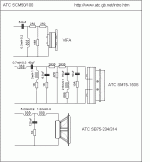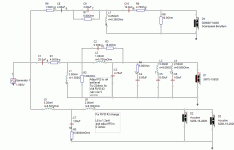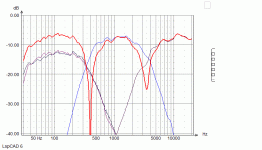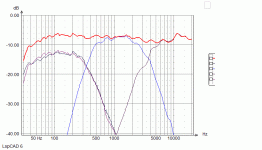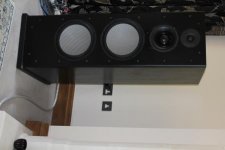Haha, no bad feelings here ) There are more important thing to fret over. However, when someone has a problem, a little help on the way is better than saying "Tough luck, sell the lot and buy something ready made" As in the this case, a few cheap cross over components and test would be quick and relatively harm free. But hey, it's the op's choice to decide….
) There are more important thing to fret over. However, when someone has a problem, a little help on the way is better than saying "Tough luck, sell the lot and buy something ready made" As in the this case, a few cheap cross over components and test would be quick and relatively harm free. But hey, it's the op's choice to decide….
If it doesn't work, so be it. Maybe lesson is learned and one can be on the way to the Nirvana of speaker building or not. Besides, people will always want to explore new areas. Take me for example, I have tinkered with speakers the last 25 years. I can get to a certain point without problem. However, I always go back to my Genelec's. Poor me, disillusioned bastard that waste my money;o)
Today, I have six channels of active filters, DSP and amps to run wild with. I can afford it and have fun with it.
After all, it's not killing someone, or? Sometimes there are too much seriousness here? Relax and take your Prozak and chill out to some good music.
Peter
If it doesn't work, so be it. Maybe lesson is learned and one can be on the way to the Nirvana of speaker building or not. Besides, people will always want to explore new areas. Take me for example, I have tinkered with speakers the last 25 years. I can get to a certain point without problem. However, I always go back to my Genelec's. Poor me, disillusioned bastard that waste my money;o)
Today, I have six channels of active filters, DSP and amps to run wild with. I can afford it and have fun with it.
After all, it's not killing someone, or? Sometimes there are too much seriousness here? Relax and take your Prozak and chill out to some good music.
Peter
Given the apparent problems at Wilmslow I would suggest that what Prestige owners need most are basic crossover circuits for the Volt and ATC versions with correct component values and supporting measurements. It now looks unlikely this will happen in this thread.Thank you for an incredbly thorough post and analysis of the various iterations involved. I think that will take me the weekend just to digest! Hopefully it will clear things up for some of the other prestige owners.
What would be ideal would be a high standard passive crossover rather than a basic one but that would need significant effort by someone that has the speakers, measurement equipment and knows, or wants to learn, how to design a passive crossover. For example, someone mentioned earlier that they added compensation for a baffle bump in the midrange passband and the midrange resonance.
After all, it's not killing someone, or? Sometimes there are too much
seriousness here? Relax and take your Prozak and chill out to some good
music.
Peter
Seriousness is fine, so is monkeying around too, in the right dosage.
I don't need any Prozac, thanks for the advice
me and I have no problem with midlife crisis because I know where I come
from and where I'm heading.
Last edited:
I couldn't agree more.Given the apparent problems at Wilmslow I would suggest that what Prestige owners need most are basic crossover circuits for the Volt and ATC versions with correct component values and supporting measurements. It now looks unlikely this will happen in this thread.
What would be ideal would be a high standard passive crossover rather than a basic one but that would need significant effort by someone that has the speakers, measurement equipment and knows, or wants to learn, how to design a passive crossover. For example, someone mentioned earlier that they added compensation for a baffle bump in the midrange passband and the midrange resonance.
Although Andy seems skeptical "..it now looks unlikely this will happen in this thread..." it would be really wonderful if the collective brain of this forum could produce a high standard passive crossover for this set of drivers, which are certainly among the best money can buy . Of course the band pass crossover should be different for the VOLT 8 Ohm mid and the 16 allOhm ATC, and the end user should be free to fine tune the general schematics by ear e.g. by changing some resistor values.
Many many thanks in advance to everybody willing to help !
Seriousness is fine, so is monkeying around too, in the right dosage.
I don't need any Prozac, thanks for the advice. My boss is not harassing
me and I have no problem with midlife crisis because I know where I come
from and where I'm heading.
Yup, however the Prozac was not prescribed specifically for you
I couldn't agree more.
Although Andy seems skeptical "..it now looks unlikely this will happen in this thread..." it would be really wonderful if the collective brain of this forum could produce a high standard passive crossover for this set of drivers, which are certainly among the best money can buy . Of course the band pass crossover should be different for the VOLT 8 Ohm mid and the 16 allOhm ATC, and the end user should be free to fine tune the general schematics by ear e.g. by changing some resistor values.
Many many thanks in advance to everybody willing to help !
Excellent idea!
You can get a speaker to sound ok in half an hour. Excellent takes time, with any crossover passive or active. The difference between the two is less of an issue. You have to do the work. You then reach the point where you can't get any better out of the cabinet and driver scheme you have.I was under the impression that creating a really excellent three-way passive crossover was a fairly difficult task and required a lot of time, listening sessions, measurements and skill. Particularly if the drivers don't have lovely flat frequency responses.
You can get a speaker to sound ok in half an hour. Excellent takes time, with any crossover passive or active. The difference between the two is less of an issue. You have to do the work. You then reach the point where you can't get any better out of the cabinet and driver scheme you have.
But isn't it true that there are efficiency gains to be had from active crossovers (even though you need more amplifiers), and also the amps see a less hostile load, which might allow them to work more accurately?
But isn't it true that there are efficiency gains to be had from active crossovers (even though you need more amplifiers), and also the amps see a less hostile load, which might allow them to work more accurately?
Most certainly. A complex crossover 'can' cause the speaker to present a really quite nasty reactive load. Prime example people quote is the original Wilson WATT which dips to 0.3 Ohms! Going active generally makes life a lot easier for the amplifiers. BUT its not necessarily easier. Some will claim you stick in a couple of LR4 slopes and some time alignment and jobs a goodun, but only if you are very very lucky.
Where can one see the mistake Wilson made with the impedance
dropping to 0,3 ohm? Passive filters can be made benign if designer
wants it to be. A smart design does not mean crossing over too low.
Speakers hard to drive go hand in hand with monster amps. They both
cost a fortune. That's the idea behind it.
dropping to 0,3 ohm? Passive filters can be made benign if designer
wants it to be. A smart design does not mean crossing over too low.
Speakers hard to drive go hand in hand with monster amps. They both
cost a fortune. That's the idea behind it.
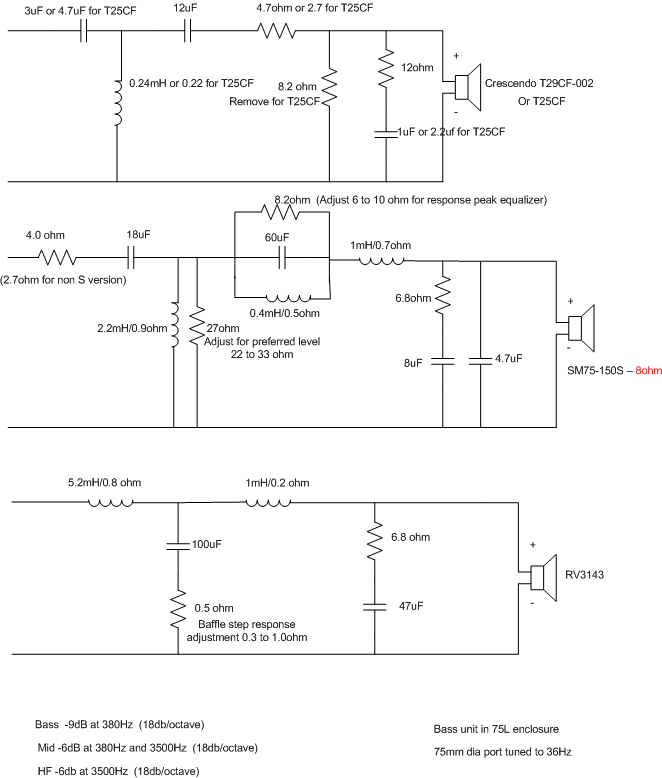
Another crossover schematics from SPD forum member
In a previous post in this thread SPD stated that the capacitor value for the notch filter on the atc should be 6 uF while in the schematics a value of 60 uF is given
SPD could you please clarify and expand your precious comments?

Another crossover schematics from SPD forum member
In a previous post in this thread SPD stated that the capacitor value for the notch filter on the atc should be 6 uF while in the schematics a value of 60 uF is given
SPD could you please clarify and expand your precious comments?
Hi
Yes this was one of my first crossover efforts for these drivers and although it does sound good, after many years improving the design and trying different bass drivers and hf units, the crossover I use now is different. I will post details later when I cam work out how to post the schematics/measurements from lspcad.
A final post regarding these ill fated crossovers...
WA have very kindly agreed to exchange them with me as they are surplus to requirements. Therefore, they are no longer an option anyway.
Take the money and run! If you need to exchange it for other merchansise, get some parts for a properly designed kit, not one of theirs.
Hi
See attached my latest xover for the ATC mid. This is for the 8ohm version of the driver and also works with the B2500.1 and RV3143 volt drivers. The xover shown uses two accuton 11" bass drivers and the new Scanspeak Beryllium tweeter. The crossover points are 380Hz and 3500Hz.
It sounds amazing.
See attached my latest xover for the ATC mid. This is for the 8ohm version of the driver and also works with the B2500.1 and RV3143 volt drivers. The xover shown uses two accuton 11" bass drivers and the new Scanspeak Beryllium tweeter. The crossover points are 380Hz and 3500Hz.
It sounds amazing.
Attachments
Hi
See attached my latest xover for the ATC mid. This is for the 8ohm version of the driver and also works with the B2500.1 and RV3143 volt drivers. The xover shown uses two accuton 11" bass drivers and the new Scanspeak Beryllium tweeter. The crossover points are 380Hz and 3500Hz.
It sounds amazing.
Thank very much SPD. Which other changes would you suggest if one uses the ATC 16ohm driver? How does the Beryllium tweeter compare to the other tweeters you have used ?( e.g. millennium, Scan-Speak 9900 Revelator) No doubt it is a very expensive driver !!
Thank very much SPD. Which other changes would you suggest if one uses the ATC 16ohm driver? How does the Beryllium tweeter compare to the other tweeters you have used ?( e.g. millennium, Scan-Speak 9900 Revelator) No doubt it is a very expensive driver !!
Hi
Without a 16ohm driver to take measurements with it's not easy to determine
component value changes. The plots show you the target response. The two notch filters should be the same for the 16ohm driver but increase the series total resistance to around 16 ohms. You need to measure to get this correct.
The baffle width for this design is 360mm.
Regarding tweeters I have also used the same mid xover with:-
1. Seas T25CF002
2. Seas T29CF002
The Scanspeak Beryllium is expensive and is hard to integrate because the response peaks in 4 -6kHz range and so lots of trial and error to get the sound good. In the end my favourite is the T25CF002. Works really good with the ATC.
Given the very large amount spent on the drivers may I ask what lead you to use a passive crossover?Hi
See attached my latest xover for the ATC mid. This is for the 8ohm version of the driver and also works with the B2500.1 and RV3143 volt drivers. The xover shown uses two accuton 11" bass drivers and the new Scanspeak Beryllium tweeter. The crossover points are 380Hz and 3500Hz.
It sounds amazing.
PS And are you using a wide cabinet with the woofers side by side or a tower?
Last edited:
- Status
- This old topic is closed. If you want to reopen this topic, contact a moderator using the "Report Post" button.
- Home
- Loudspeakers
- Multi-Way
- Wilmslow Audio - Prestige platinum
